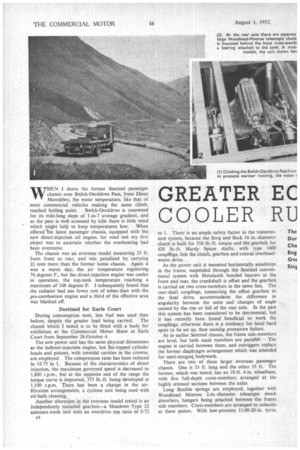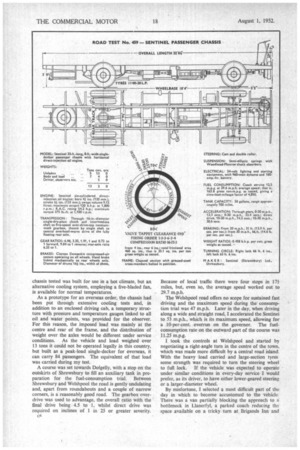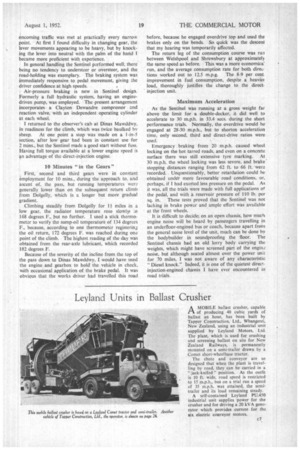GREATER EC COOLER RI] 1NOMY: NING
Page 42

Page 43

Page 44

Page 45

If you've noticed an error in this article please click here to report it so we can fix it.
The Our Cha Eng Ove Sins racteristics were Revealed Test of a Sentinel Bus with Direct-injection Oil though it was Loaded to is Gross Weight, Equal to a er Carrying 84 Passengers
Sy Laurence J. Cotton, M.I.R.T.E. WHEN I drove the tormer Sentinel passenger chassis over Bwlch-Oerddrws Pass, from Dinas Mawddwy, the water temperature, like that of most commercial vehicles making the same climb. reached boiling point. Bwlch-Oerddrws is renowned for its mile-long slope of 1-in-7 average gradient, and as the pass is well screened by hills there is little wind which might help to keep temperatures low. When offered 'the latest passenger chassis, equipped with the new direct-injection oil engine, for road test my first object was to ascertain whether the overheating had been overcome.
The chassis was an overseas model measuring 33 ft. from front to rear, and was penalized by carrying 2+ tons more than the former home chassis. Again it was a warm day, the air temperature registering 74 degrees F., but the direct-injection engine was cooler in operation, the top-tank temperature reaching a maximum of 168 degrees-F. I subsequently found that the radiator had one fewer row of tithes than with the pre-combustion engine and a third of the effective area was blanked off.
Destined for Earls Court
During consumption tests, less fuel was used than before, despite the greater load being carried. The chassis which I tested is to be fitted with a body for exhibition at the Commercial Motor Show at Earls Court from September 26-October 4.
The new power unit has the same physical dimensions as the indirect-injection engine, but flat-topped cylinder heads and pistons, with toroidal cavities in the crowns, are employed. The compression ratio has been reduced to 16.75 to 1. Because of the characteristics of direct injection, the maximum governed speed is decreased to 1,800 r.p.m., but at the opposite end of the range the torque curve is improved, 375 lb.-ft. being developed at 1,100 r.p.m. There has been a change in the airfiltration arrangements, a cyclone unit being used with
oil-bath cleaning. .
Another alteration in the overseas model tested is an independently mounted gearbox—a Meadows Type 22 constant-mesh unit with an overdrive top ratio of 0.72 c4
to I. There is an ample safety factor in the transmission system, because the Borg and Beck 16 in.-diameter clutch isbuilt for 510 lb.-ft. torque and the gearbOx for 420 lb.-ft. Hardy Spicer shafts, with type 1600 coupltngs, link the clutch, gearbox and central overheadworm drive. .
As the power unit is mounted horizontally amidships in the frame, suspended through the Sentinel conventional system with Metalastik bonded bearers at the front and rear, the crankshaft is offset and the gearbox is carried on two cross-members in the same line. The rear-shaft couplings, connecting the offset gearbox to the final drive, accommodates the difference in angularity between the units and changes of angle caused by the rise or fall of the rear axle. In the past this system has been considered to he detrimental, but it has recently been found beneficial to work the couplings, otherwise there is a tendency for local hard spots to be set up, thus causing premature failure.
As in earlier Sentinel chassis, the frame side-members are level, but both main members are parallet ---The engine is carried between them, and outriggers replace the former diaphragm arrangement which was intended for semi-integral, bodywork.
There are two of these larger overseas passenger chassis. One is 33 ft. long and the other 35 ft. The former, which was tested, has an 18-ft. 4-in, wheelbase, with five full-depth cross-members arranged at the highly stressed sections between the axles.
Long flexible springs are employed, together with Woodhead Monroe 2:in.-diameter telescopic shock absorbers, hangers being attached between the frame side members. Cross-members are arranged to coincidu at these points. With low-pressure 11.00-20-in. tyres,
single at the front and twin at the rear, the frame height is 3 ft. Of in. when loaded to the maximum gross weight of 13 tons. The front overhang of 5 ft. 5 ins. affords space for a 2-ft. 9-in.-wide door between outriggers, and a double door could be provided on the rear overhang or between the axles.
The dynamo-and 10-cubic-ft. compressor are beltdriven from the intermediate shaft connecting the clutch and gearbox. The radiator, which projects partly above frame level immediately behind the front cross-member, has a full shroud and an aerofoil nine-bladed fan driven at crankshaft speed by a two-piece jackshaft. The
chassis tested was built for use in a hot climate, but an alternative cooling system, employing a five-bladed fan, is available for normal temperatures.
As a prototype for an overseas order, the chassis had been put through extensive cooling tests and, in addition to. an enclosed driving cab, a temporary structure with pressure and temperature gauges linked to all oil and water points, was provided for the observer. For this reason, the imposed load was mainly at the centre and rear of the frame, and the distribution of weight over the axles would be different under service conditions. As the vehicle and load weighed over 13 tons it could not be operated legally in this country, but built as a peak-load single-decker for overseas, it can carry 84 passengers. The equivalent of that 'load was carried during my test.
A course was set towards Dolgelly, with a stop on the outskirts of Shrewsbury to fill an auxiliary tank in preparation for the fuel-consumption trial. Between Shrewsbury and Welshpool the road is gently undulating and, apart from roundabouts and a couple of narrow corners, is a reasonably good road. The gearbox overdrive was used to advantage, the overall ratio with the final drive being 4.5 to 1, whilst direct drive was required on inclines of 1 in 25 or greater severity.
c6 Because of local traffic there were four stops in 171 miles, but, even so, the average speed worked out to 29.7 m.p.h.
The Welshpool road offers no scope for sustained fast driving and the maximum speed during the consumption trial was 47 m.p.h. Later in the day, when driving along a wide and straight road, I accelerated the Sentinel to 53 m.p.h., which is its maximum speed, allowing for a 10-per-cent. overrun on the governor. The fuelconsumption rate on the outward part of the course was 11.25 m.p.g.
I took the controls at Welshpool and started by negotiating a right-angle turn in the centre of the town, which was made more difficult by a central road island. With the heavy load carried and large-section tyres some strength was required to turn the steering wheel to full lock. If the vehicle, was expected to operate under similar conditions in every-day service I would prefer, as its driver, to have either lower-geared steering or a larger-diameter wheel.
By misfortune, I selected a most difficult part of the day in which to become accustomed to the vehicle. There was a van partially blocking the approach to a bottleneck in Llanerfyl, a parked coach reducing the space available on a tricky turn at Brigands Inn and oncoming traffic was met at practically every narrow point. At first I found difficulty in changing gear, the lever movements appearing to be heavy, but by knocking the lever into neutral with the palm of the hand I became more proficient with experience.
In general handling the Sentinel performed well, there being no tendency to understeer or oversteer, and the road-holding was exemplary. The braking system was immediately responsive to pedal movement, giving the driver confidence at high speeds.
Air-pressure braking is new in Sentinel design. Formerly a full hydraulic system, having an enginedriven pump, was employed. The present arrangement incorporates a Clayton Dewandre compressor and reaction valve, with an independent operating cylinder at each wheel.
I returned to the observer's cab at Dinas Mawddwy, in readiness for the climb, which was twice baulked by sheep. At one point a stop was made on a 1-in-5 section, after low gear had been in constant use for 2 mins., but the Sentinel made a good start without fuss. Having full torque available at a lower engine speed is an advantage of the direct-injection engine.
10 Minutes "in the Gears" First, second and third gears were in constant employment for 10 mins., during the approach to, and ascent of, the pass, but running temperatures were. generally lower than on the subsequent return climb from Dolgelly, which is a longer but more gradual gradient.
Climbing steadily from Dolgelly for 1 + miles in a low gear, the radiator temperature rose slowly, zo 168 degrees F., but no further. I used a stick thermometer to verify the sump-oil temperature of 134 degrees F., because, according to one thermometer registering the oil return, 172 degrees F. was reached during one point of the climb. The highest reading of the day was obtained from the rear-axle lubricant, which recorded 182 degrees F.
Because of the severity of the incline from the top of the pass down to Dinas Mawddwy, I would have used the engine and gearbox to hold the vehicle in check, with occasional application of the brake pedal. It was obvious that the works driver had travelled this road
before, because he engaged overdrive top and used the brakes only on the bends. So quick was the descent that my hearing was temporarily affected.
The return leg of the consumption course was rua between Welshpool. and Shrewsbury at approximately the same speed as before. This was a more economica' run, and the average consumption rate for both direc
tions worked out to 12.5 m.p.g. The 8-9 per cent. improvement in fuel consumption, despite a heaviet load, thoroughly justifies the change to the direct• injection unit.
Maximum Acceleration As the Sentinel was running at a gross weight far above the limit for a double-decker, it did well to accelerate to 30 m.p.h. in 33.4 secs, during the short performance trials. Normally, the overdrive would be engaged at 28-30 m.p.h., but to shorten acceleration time, only second, third and direct-drive ratios were used.
Emergency braking from 20 m.p.h. caused wheel locking on the hot tarred roads, and even on a concrete
surface there was still extensive tyre marking. At 30 m.p.h. the wheel locking was less severe, and brake' stopping distances ranging from 62 ft. to 66 ft 'were. recorded. . Unquestionably, better retardation could he obtained under more favourable road conditions, or, perhaps, if I had exerted less pressure on the pedal. As it was, all the trials were made with full applications of the pedal, and with a reservoir pressure of 110 lb. per sq. in. These tests proved that the Sentinel was not lacking in brake power and ample effort was available at the front wheels.
It is difficult to decide; on an open chassis, how much engine noise will be heard by passengers travelling in an underfloor-engined bus or coach, because apart from the general noise level of the unit, much can be done by the bodybuilder in soundproofing the floor. The Sentinel chassis had an old lorry body carrying the weights, which might have screened part of the engin.: noise, but although seated almost over the power un;t for 70 miles, I was not aware of any characteristic "Diesel knock." Indeed, it is one of the quietest directinjection-engined chassis I have ever encountered in road trials.




















































































